THE GREEN STREETS OF PARIS; STREET TREES SHADE PARISIANS AND SHED LIGHT ON Â ITS ARBOREAL HISTORY Â
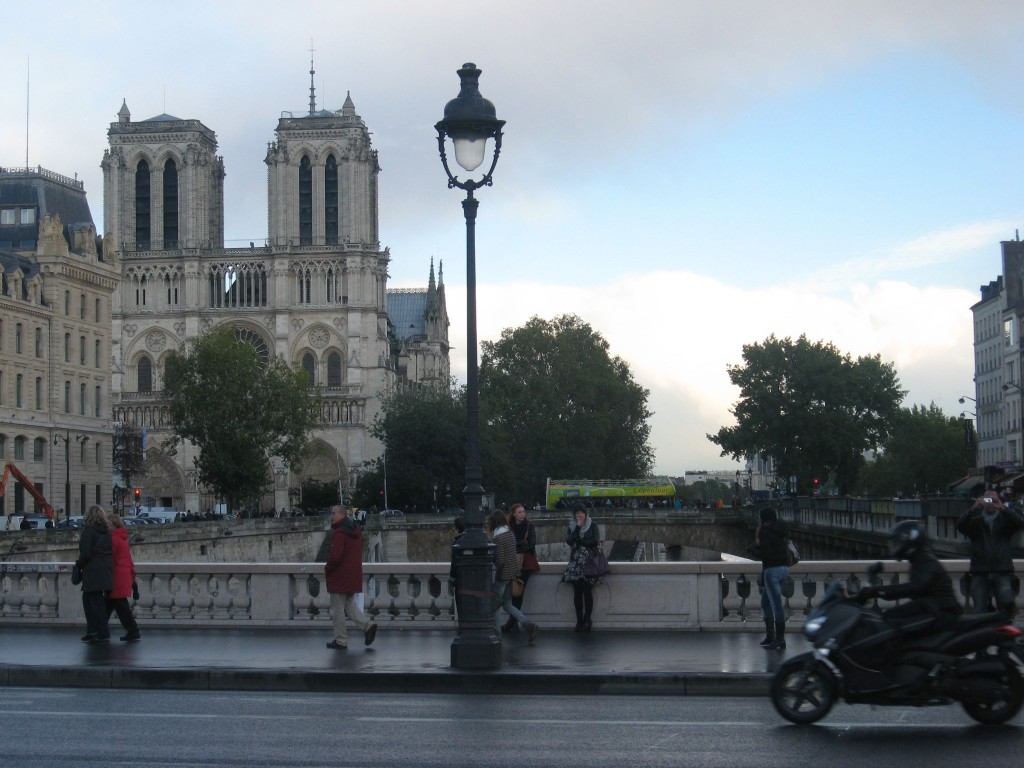
Walking the streets of Paris is a favorite pastime of ours, so much that we must plan for days of unplanned walks between engagements and gatherings. Once the time is established for wholehearted play in France’s City Of Trees, the walks become serendipitous wanderings that carry us through the Paris of centuries, where discoveries are made, and adventures are had, in which we cross through the boundaries of sight-seeing into the daily routines of Parisians. We know we have made that special entry into the streets of Paris when we have  wandered off into a district  accidentally and we find ourselves at once very much part of the routine, and at the same time experiencing it as fresh observers. We are waiting in line in a patisserie to get those fresh croissants and a baguette (for later) and then find ourselves looking for a delicious cheese in the neighborhood grocery, so we can keep walking, stopping all along the way in the many small parks that have been established all throughout the city. The first part of our venture is assembling a picnic, which we spend the afternoon eating as we go along.
The exploration of Paris has been a varied experience, ranging from grand vistas of the city attributed to the visitation and ascension of  the astounding monuments that have attained global iconic status to the most modest nooks and tiny staircases. Little houses snugged between late 19th century apartment buildings. We have discovered streets completely devoid of trees wide enough for a horse cart.  Often times we will end up spending the remainder of the day in a newly discovered neighborhood, starting out at the local cafe ordering deux cremes s’il vous plait (two expressos with milk, please), after which we window shop at the various businesses and most likely we come across a community garden and we always stop and sit down at the local city park for our picnic. In Paris neighborhoods there are always surprises, like a squatted vacant lot that has become an urban farm, complete with a cardboard box of free vegetables, or a roman amphitheater tucked into a hillside, which has been transformed into a neighborhood park.  We get a feel for the day-to-day life and the history; every neighborhood has its own atmosphere, on some blocks even a mood; the sense of place in Paris has an impressive imprint  on visitors and Parisians alike.
The trees of Paris streets has become a fascinating subject as we have become more interested in trees generally and as we have explored more and more of the city. Street trees especially have been something of a matter of discussion as we observe our own street trees in our fair city, Philadelphia, Pennsylvania. Street trees have become a subject of importance for city dwellers, and we have been navigating this subject for a few years now. What a better tableau than Paris to bring it up! Our explorations of Paris have been pleasant and enjoyable and truly educational on so many levels, especially those considering the ecology of the city. We find that Paris and Philadelphia  share much in common with each other at the curbside; like our trash collection and recycling, our street trees are also related genetically.
You are invited to stroll the streets of Paris with us, and admire and discuss the trees!
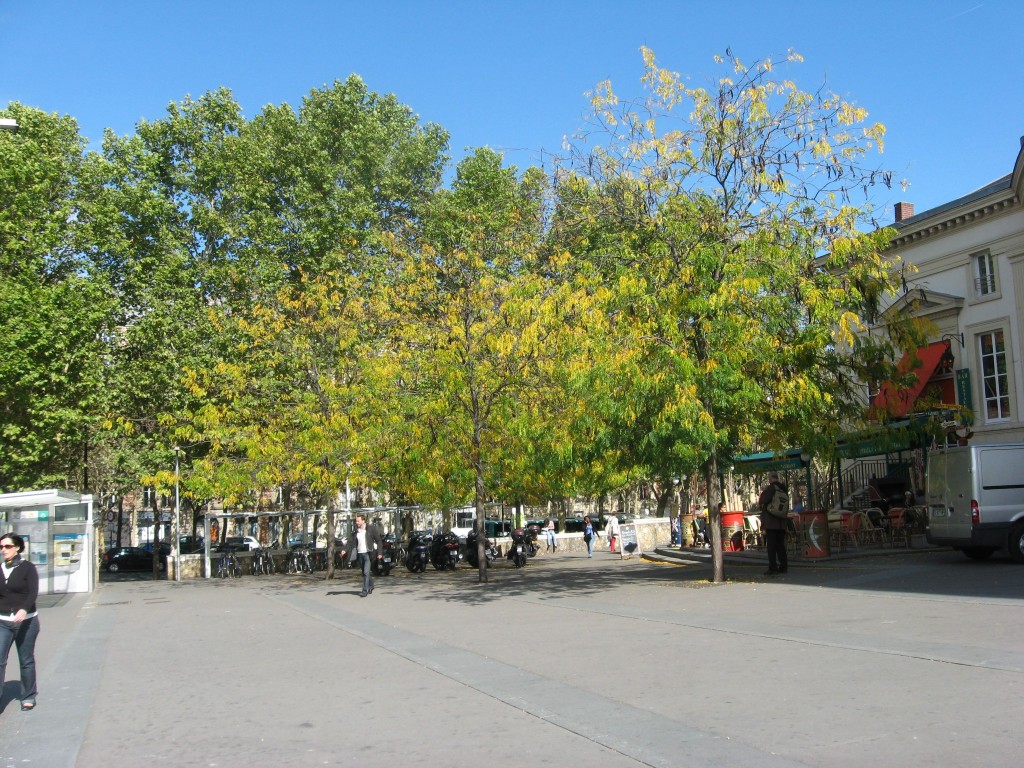
Our exciting adventures through the neighborhoods of Paris have revealed to us the most crispy croissants on the outside and the tenderest on the inside as well as the most favorite street trees of the past quarter century, the American Honey Locust! Like the Parisian croissant, the American native Honey Locust delivers a satisfying one two three deliverance of product that truly gets the job done: An attractive tree, fast growing, and easy maintenance: In the fall,the tiny leaflets just blow away from the site. Â This tree is a favorite street tree.
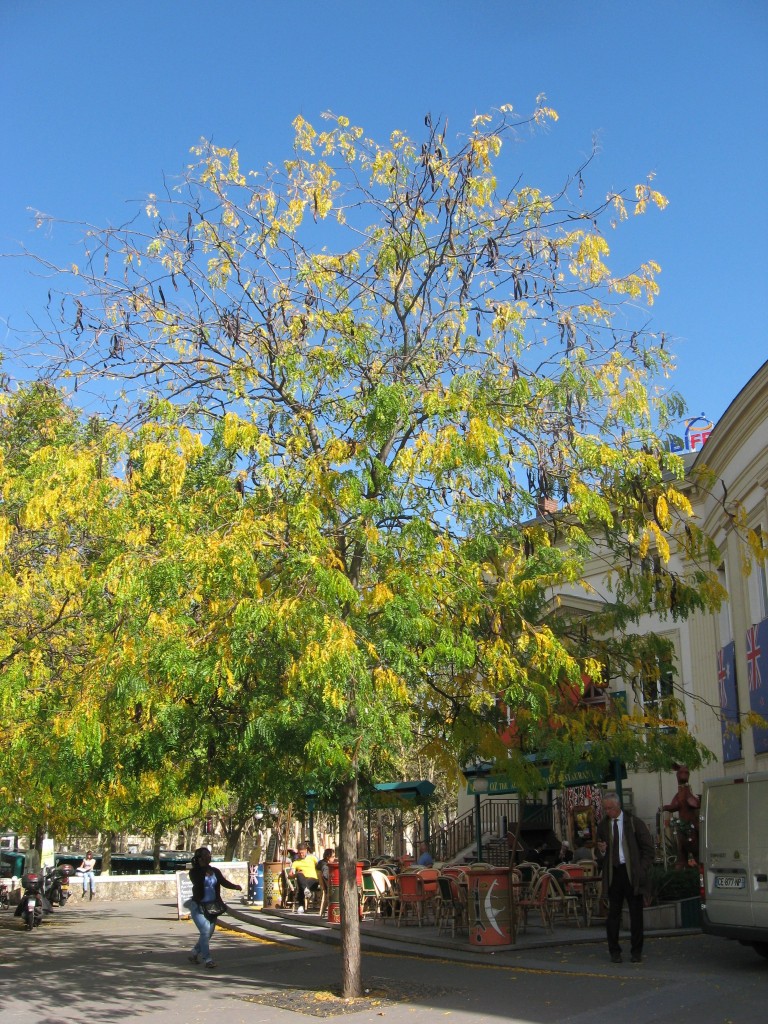
Great fall color too. The Honey locust has adapted to the urban environment beautifully. It is embraced in Philadelphia as well, and can grow out of large pots too. A truly successful street tree requires minimal maintenance, and the ability to withstand harsh conditions. The tiny leaves of the Honey Locust are its biggest advantage in its street tree role, by just blowing away at the end of the season.
As for problems, the Honey Locust has a few which we should be aware of: The genetic provenance of the street trees planted is weak, which means that most of the trees are derived from a few (at best) selections of the best varieties, and while these varieties have the most characteristics favoring street tree optimization, they may fail  prematurely in the sudden disease category. Genetically selected species are ones with a specific genetic blueprint, often one suited for a specific characterization, such as a preferred growth habit, flowering habit, etc., but not necessarily with a long term plan or survival strategy. What we are suggesting here is that a street planted up entirely with Honey Locusts that have been selected out genetically for their great adaptiveness, may end up a liability in the long run as these trees may be more susceptible to disease and blight, leaving the street vulnerable to falling and dead trees as well as a complete loss of them.
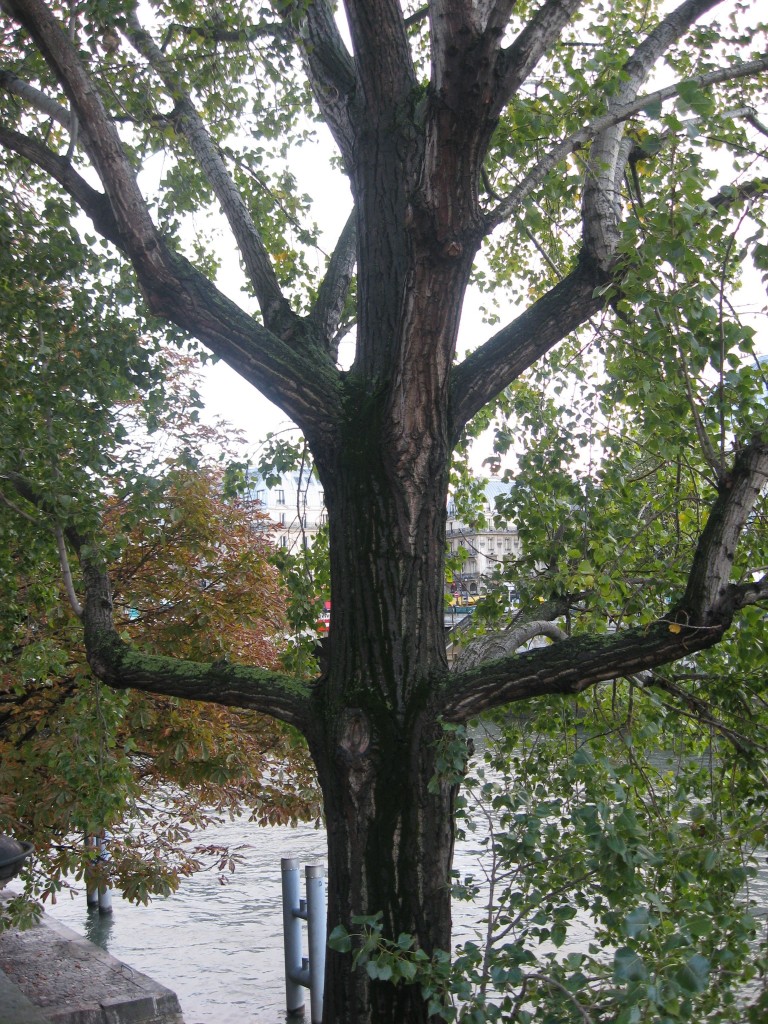
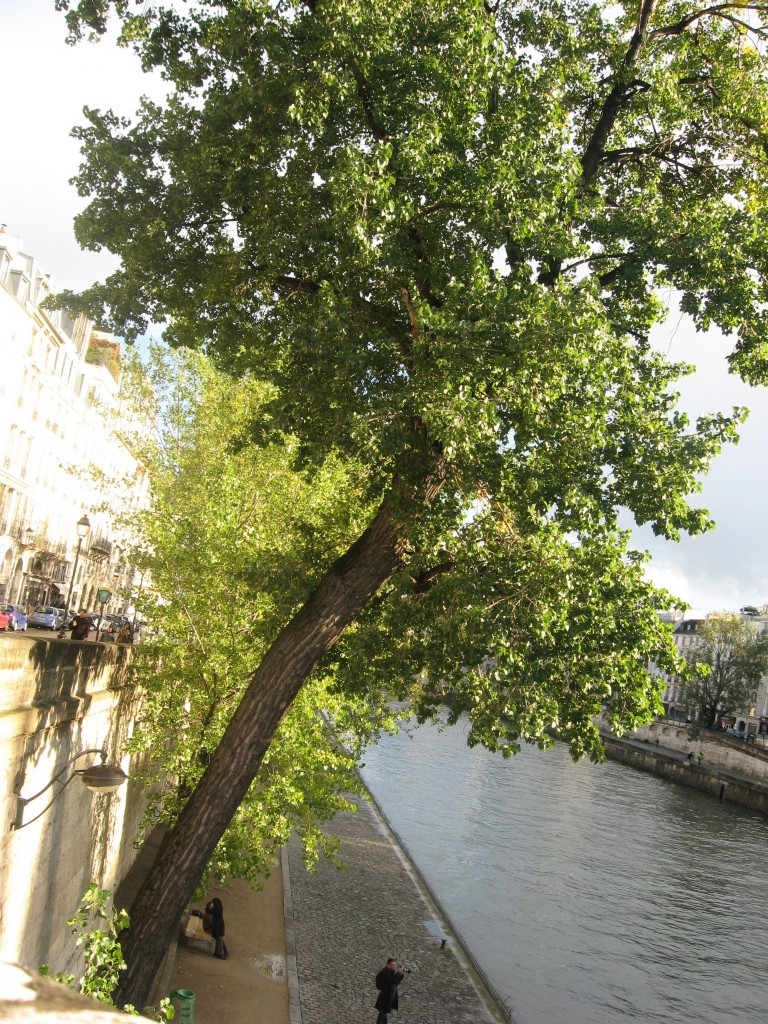
Walking from The Louvre to Place St. Michel, there is a pleasing row of Linden trees along the Seine. These trees have an attractive light green seed in the summer months, which contrasts nicely with the dark green spade shaped leaves. As for growth habit, the first Linden tree picture says it all!
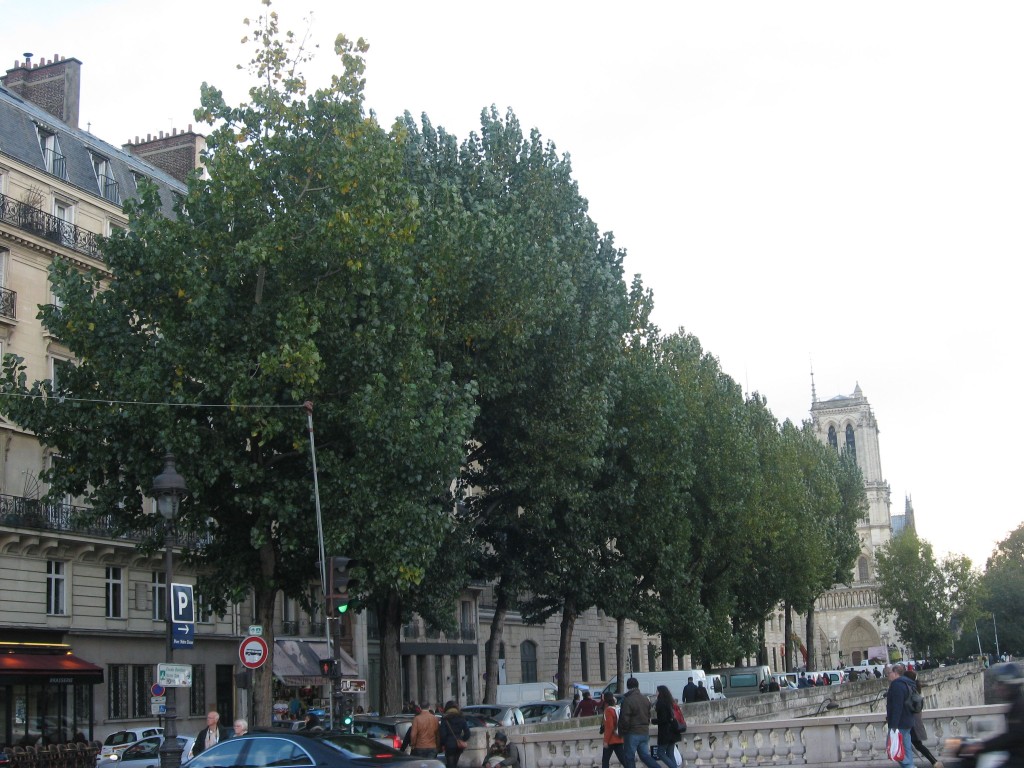
There is a lot of room along the Seine, and the city allows these trees to express their natural growth habit, something often not seen in many streets, especially in the suburbs.
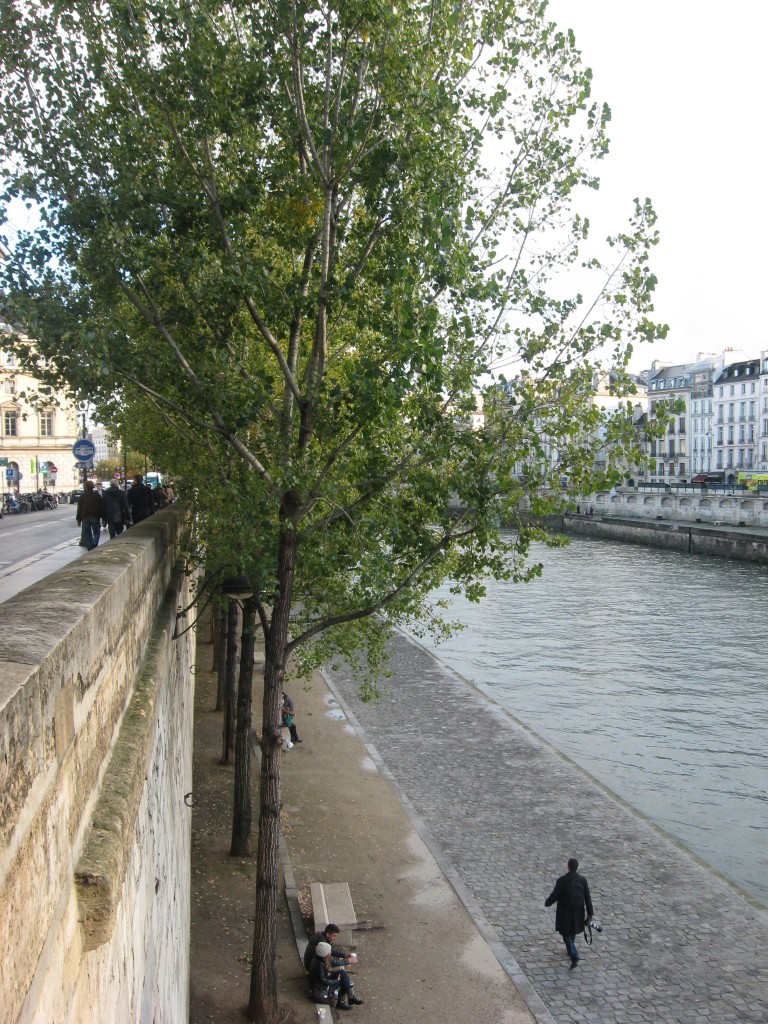
Street trees of the same kind, planted in long rows have an aesthetic appeal that is especially fitting to cities. In Paris, mature, matching trees in a row speak volumes about the sense of place they provide; there is a grandiosity that is particularly  fitting to the capital of France and the seat of French culture. They are an extension of the French Garden-into the streets these enormous sylvan caryatids are unleashed unto the city in every direction, gracing in symmetrical equilibrium the magnificence of the boulevards and the buildings. These street trees lead us into the Garden of the Tuileries, the Luxembourg Gardens, The Invalides,  in a perfect continuum from the built environment into the carefully planted, cultivated and purposely unbuilt one. In this manner, the street trees of Paris carry a cultural significance as they extend the ideal of what we now call the French garden into the city streets, to be enjoyed by all.
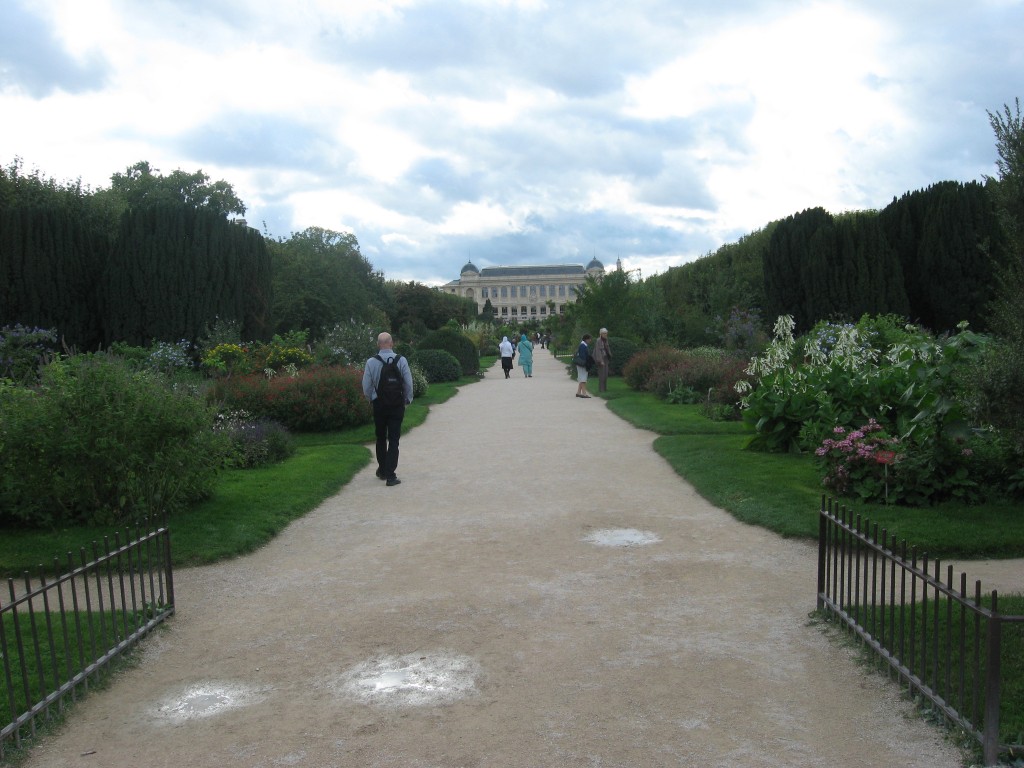
Here is an example of the French Garden, with the symmetrical arrangements of trees and garden beds as well as a central formal axis leading to an important structure, one that defines the property, such as a chateau or palace. Â This French garden is unique in that its repetitive garden beds are a museum of plants, exhibiting a diversity of plants that extend across the globe, some of them even considered weeds!
In this setting, the French Garden is more than appropriate, as it has become a backdrop to the study and classification of plants. The formal layout serves the observer by being a routine context that allows the visitor to focus on the plants themselves and less on the garden setting.
So close and yet so far, we find ourselves in another neighborhood altogether.
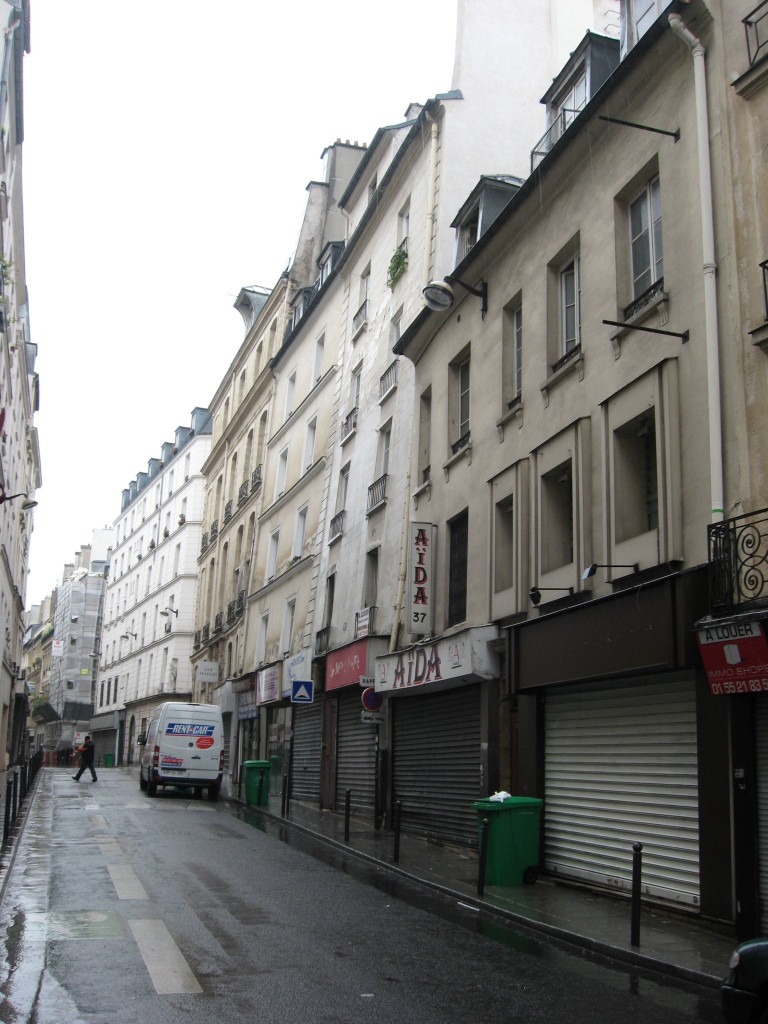
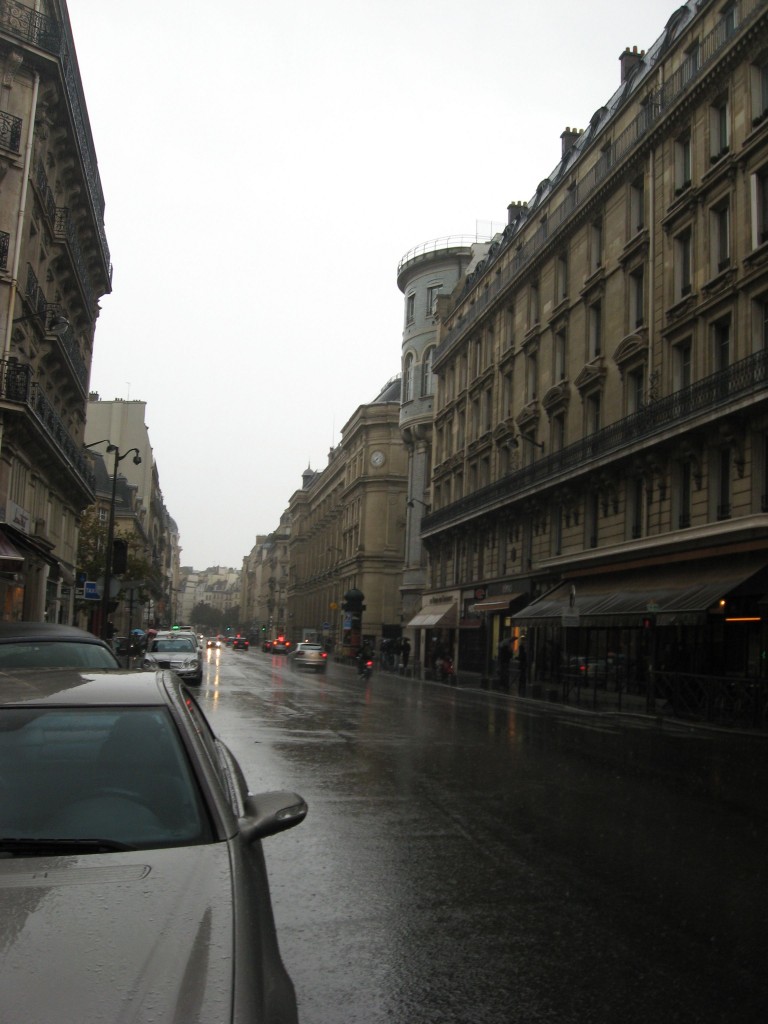
On many streets of Paris, there are few to no trees. There is little room for them.
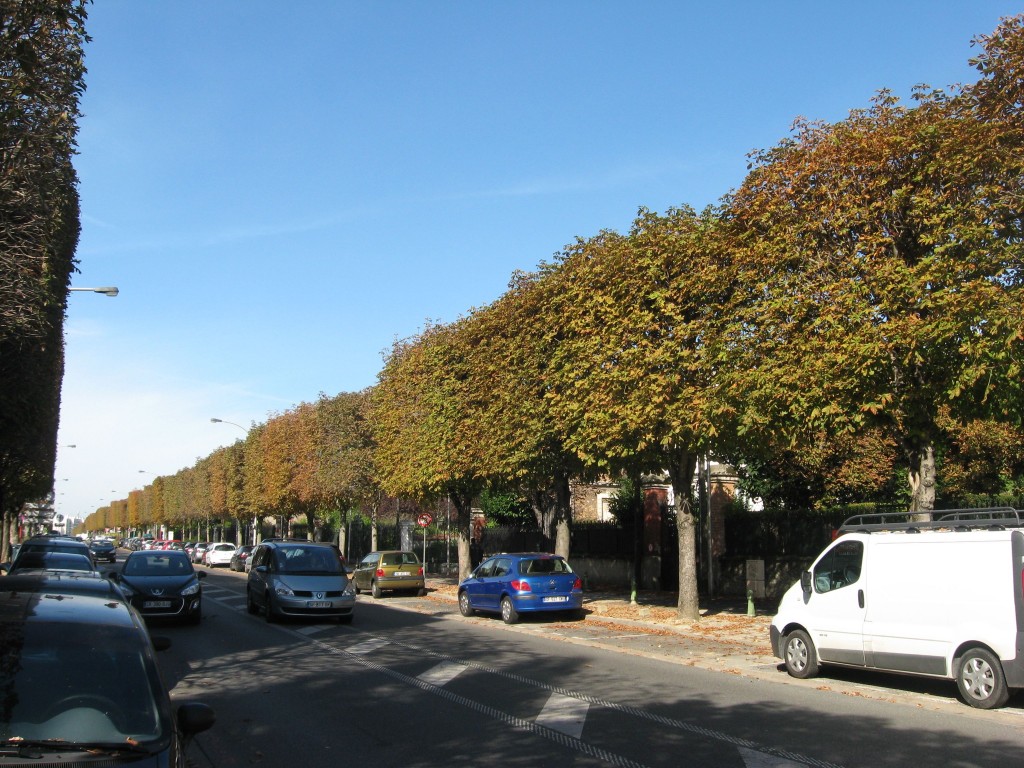
In this picture we can clearly see how the trees are pruned top-to-bottom in a square fashion in the Paris suburb of Le Raincy. These Trees are Horse Chestnuts, and they line both sides of the street and go as far as the eye can see.
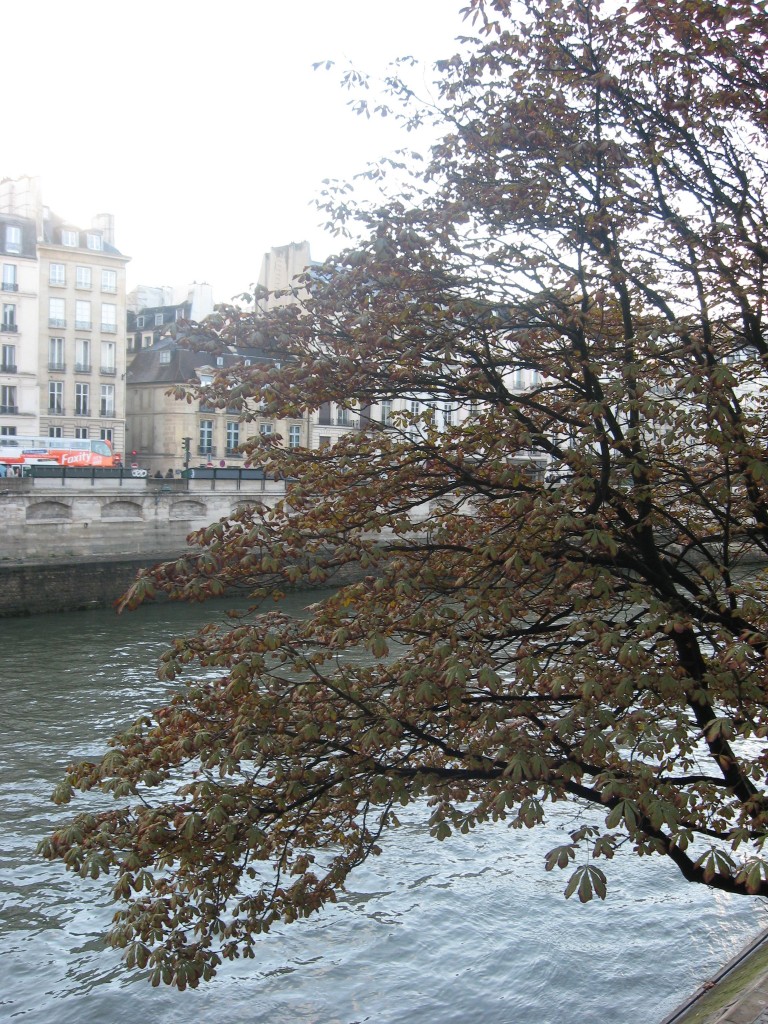
Along the Seine, the Horse Chestnut is allowed the luxury of uninhibited growth, and this tree fulfills the promise of unabated beauty along the water! The dark branches in contrast to the leaves is stunning. Â This European tree, with a very small range of indigenous habitat in eastern Europe, had become vastly popular as a street tree.
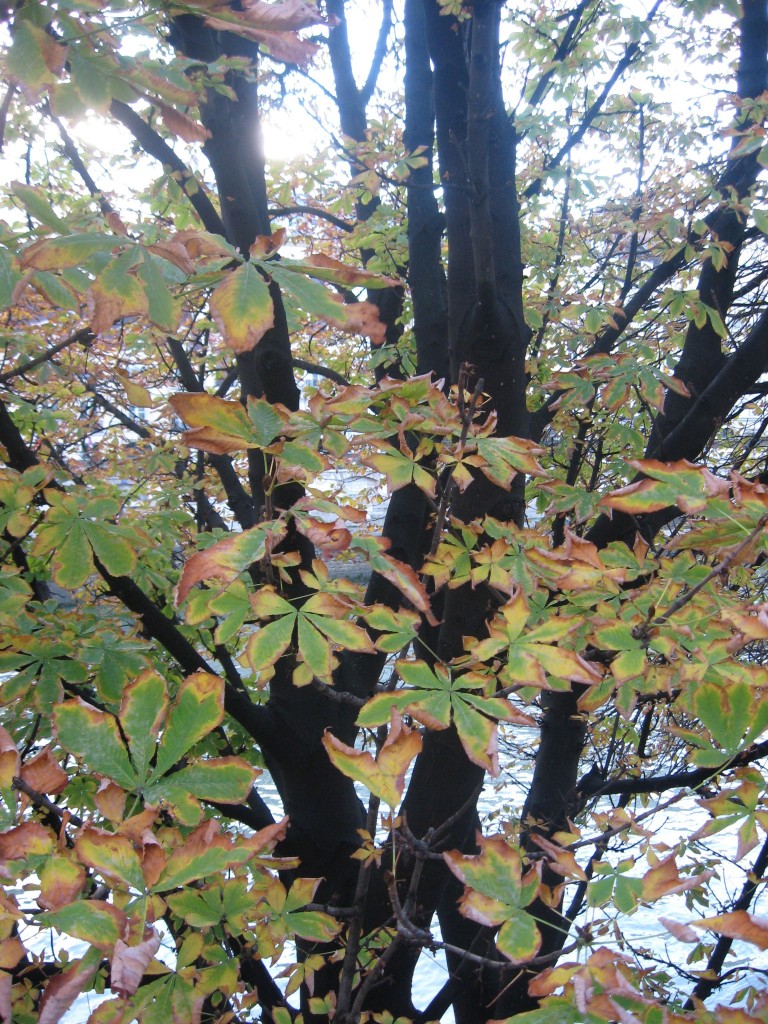
Along the water, in the fall, the Horse Chestnut provides a distinctive texture, in this case a contrasting of colors and silhouette  against the watery backdrop of the Seine.
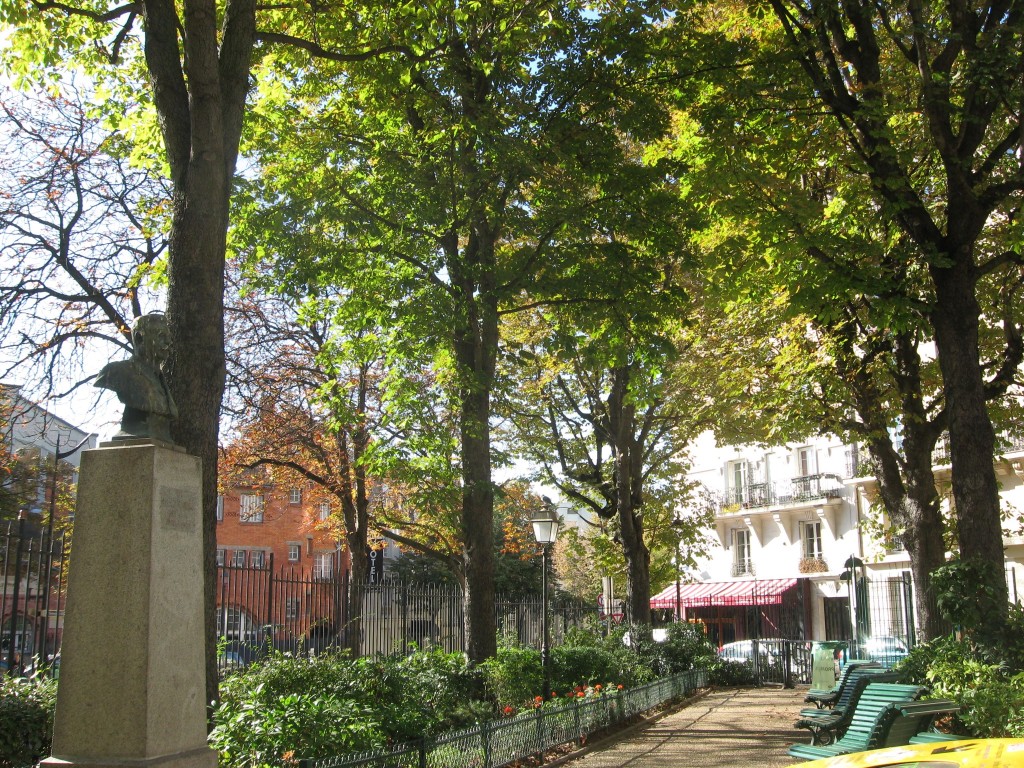
Found throughout the city, the Horse Chestnut as a species, is the dominant tree across many a park and blocks of streets.
In this park in the Butte Aux Cailles neighborhood we enjoyed pain au chocolat, which is a croissant filled with chocolate from the local patisserie, just the thing after arriving in Paris from a transatlantic overnight flight!
In that sleepless and disoriented state, the idea of the street trees of Paris, as a subject, came into focus.
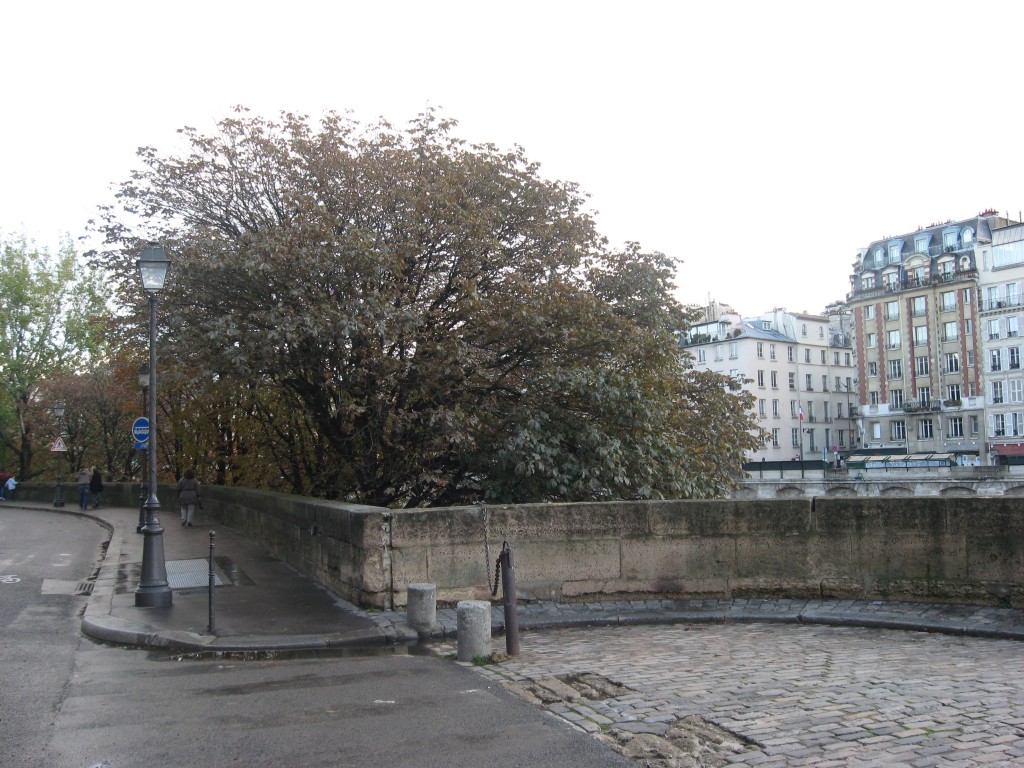
Paris is included among the most grand of cities that is full of spaces in beautiful locations that are just there and have become an afterthought of urban planning, these spots being the ones left behind in the overall visions of the many city-makers through the centuries. Sometimes these places become interesting as charming nooks and crannies that make for a pleasing urban experience, and most often they are just paved over or allowed to become overgrown with weeds. The specific nook pictured above, came into the world with the intention of creating a pleasant space to view the river, but somehow has fallen short of its goal, and remains neglected.
However, it has allowed great views of the Horse Chestnut trees that serve to soften the hardened urban landscape, giving the Seine a more naturalistic look, something the river itself sorely lacks in Paris due to the much needed flood control walls erected to protect the city.
Perhaps shrubs could be utilized as a complement to the trees.
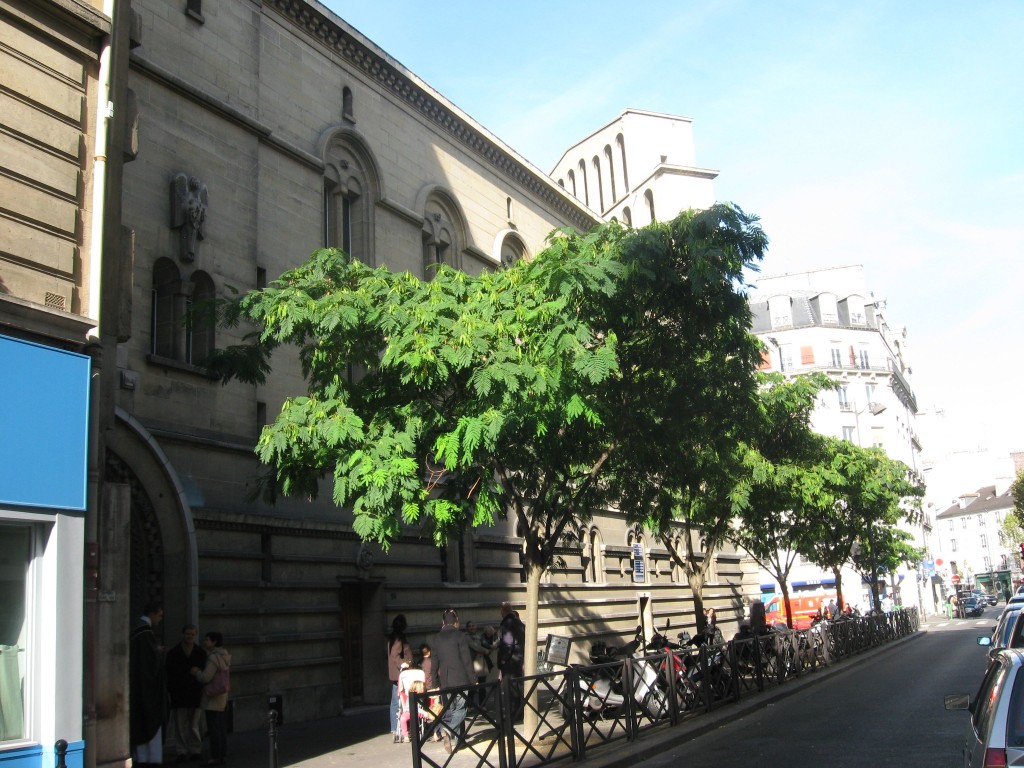
Albizia julibrrissin
Paris, full of surprises, offered us this unique view of the Mimosa, being utilized as a street tree, planted in a neat row. Usually this tree is found growing alongside railroad tracks or in a vacant lot as an invasive weed tree. It seeds itself aggressively, and we are always removing seedlings from our yard and Morris Park.
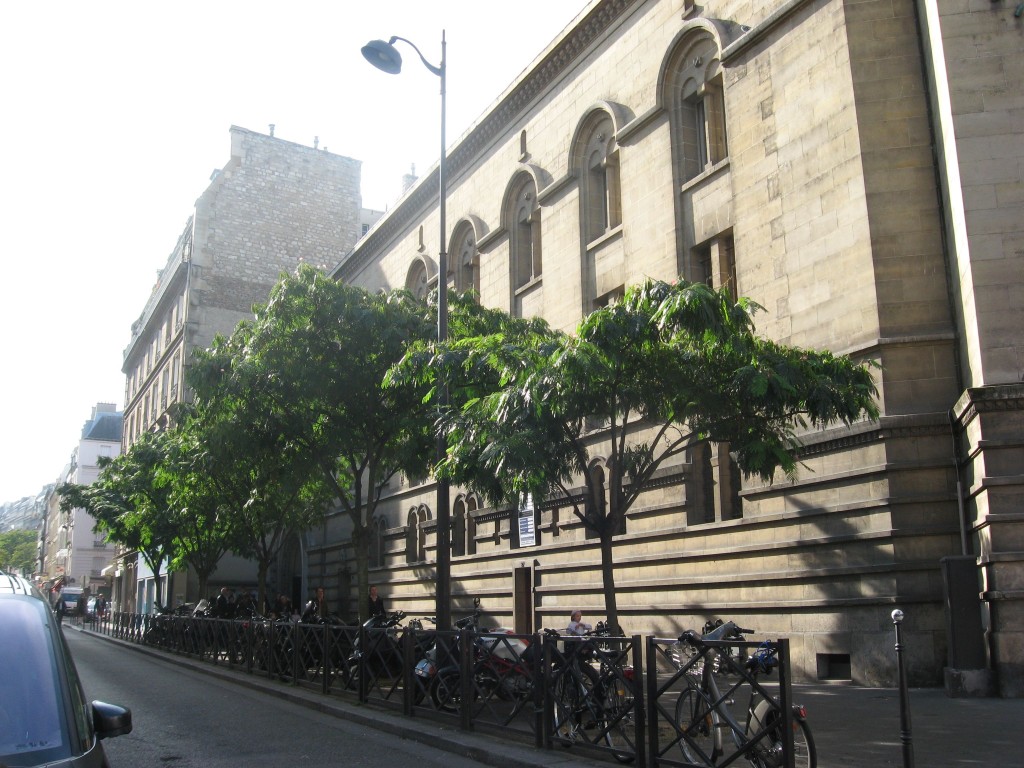
Pruned nicely, these Mimosa do create an elegant row of specimens.
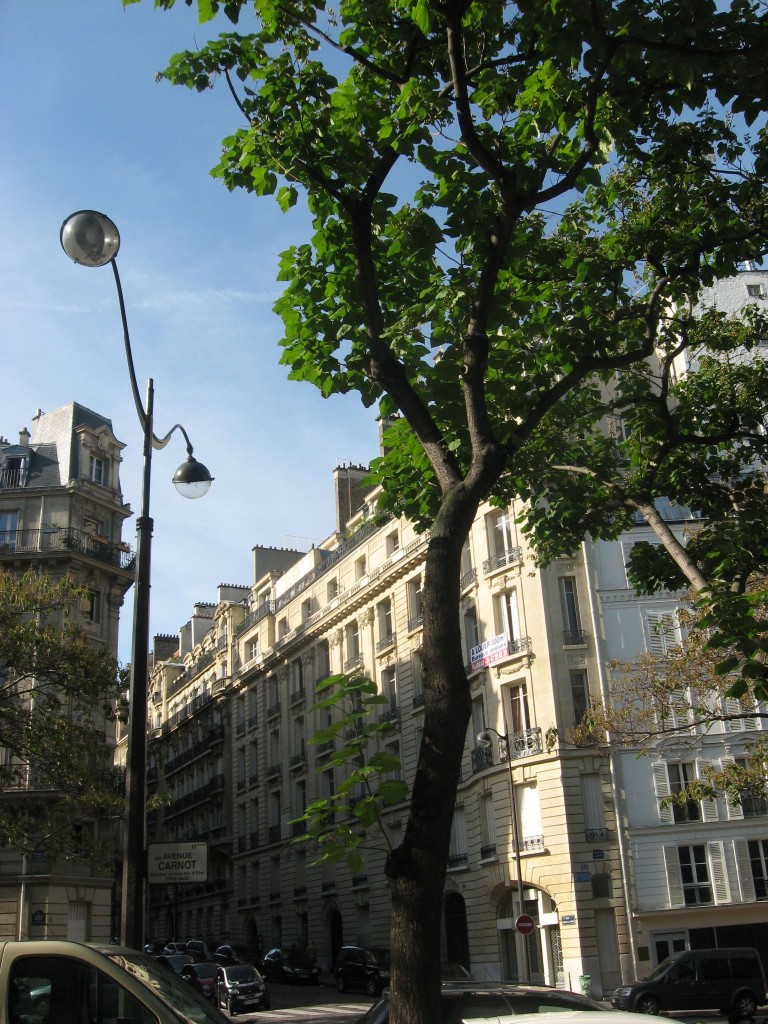
Up the street, we are confronted with the Paulonia tomentosa, the Empress tree. Also one we are not used to seeing as a street tree, (except for Logan Square in Philadelphia).
These are grand specimens, growing in the near vicinity to the grandiose, awesome and iconic Arc de Triomphe.
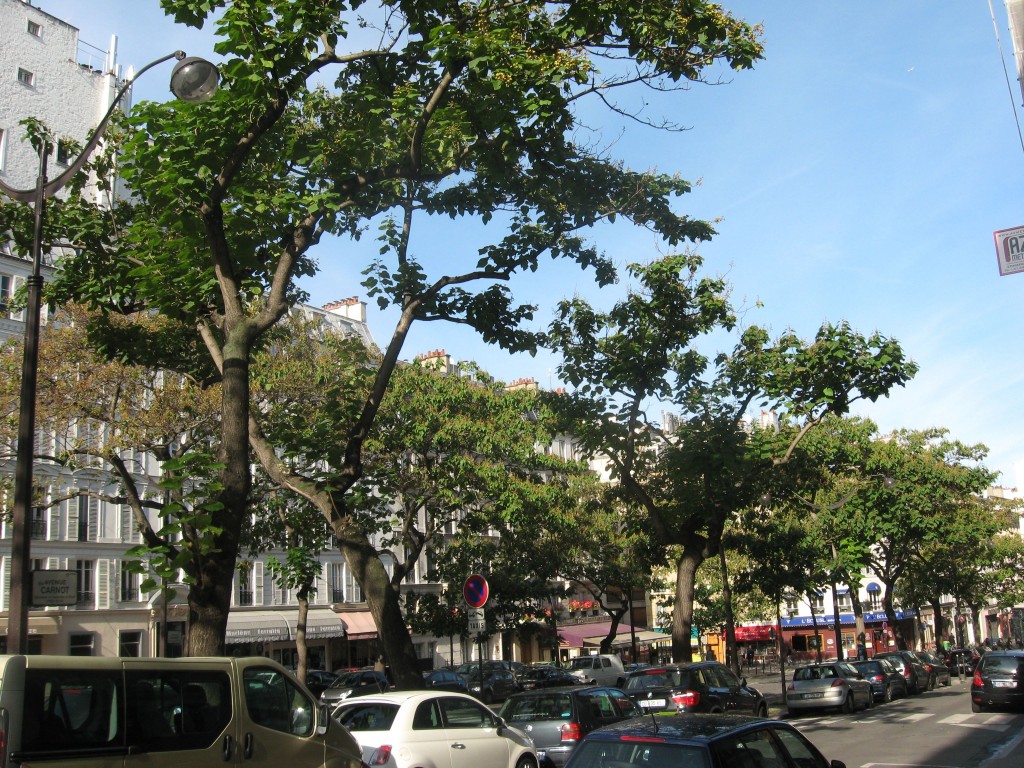
Also a weed tree, the Empress is a nuisance when left untended and unnoticed until it is a problem. This fast growing asian native has beautiful purple flowers, but throws out seeds that like to grow out of the sides of buildings. From the picture above, even the city of Paris has had some difficulties trying to get these specimens to grow in an elegant and controlled manner.
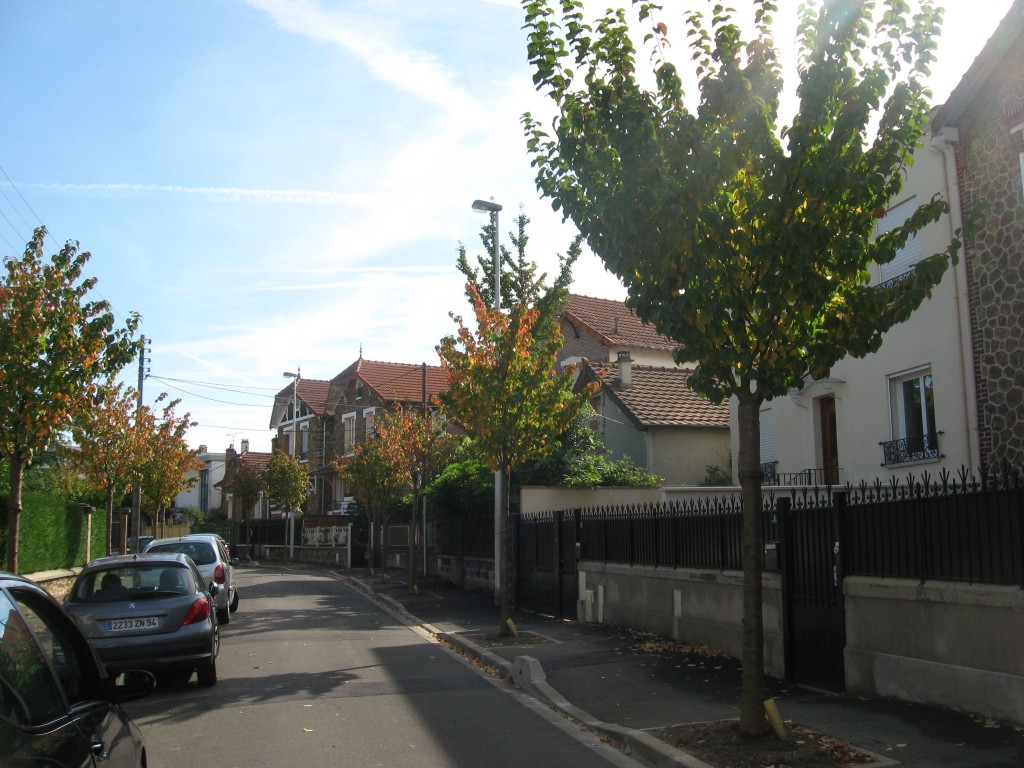
These Japanese Cherry Trees were planted three years ago in the Paris suburb of Le Raincy.
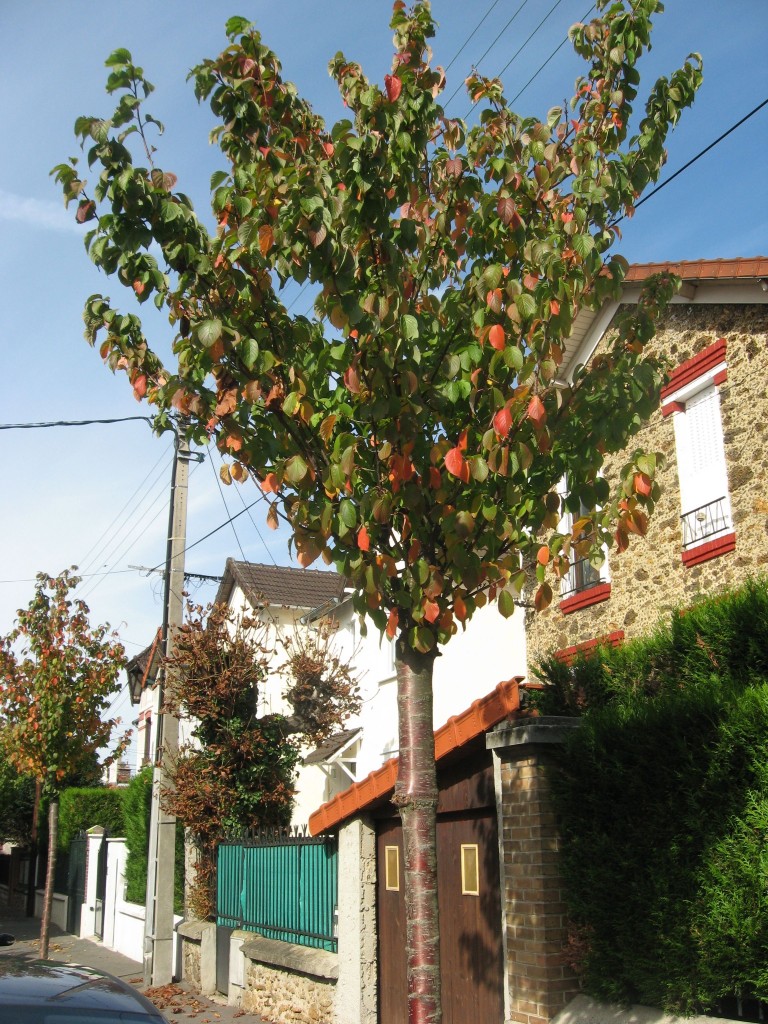
All in a row. It is very interesting to see what is being planted, and in what sorts of arrangements-a single species in rows, small trees, large trees, or a variety of trees. What is being planted tells as much of a story as that which has been planted over the years.
Japanese Cherrys are widely planted in Philadelphia, and they have beautiful, much admired blooms in the spring. They have escaped into Morris Park and other natural areas in and around the city.
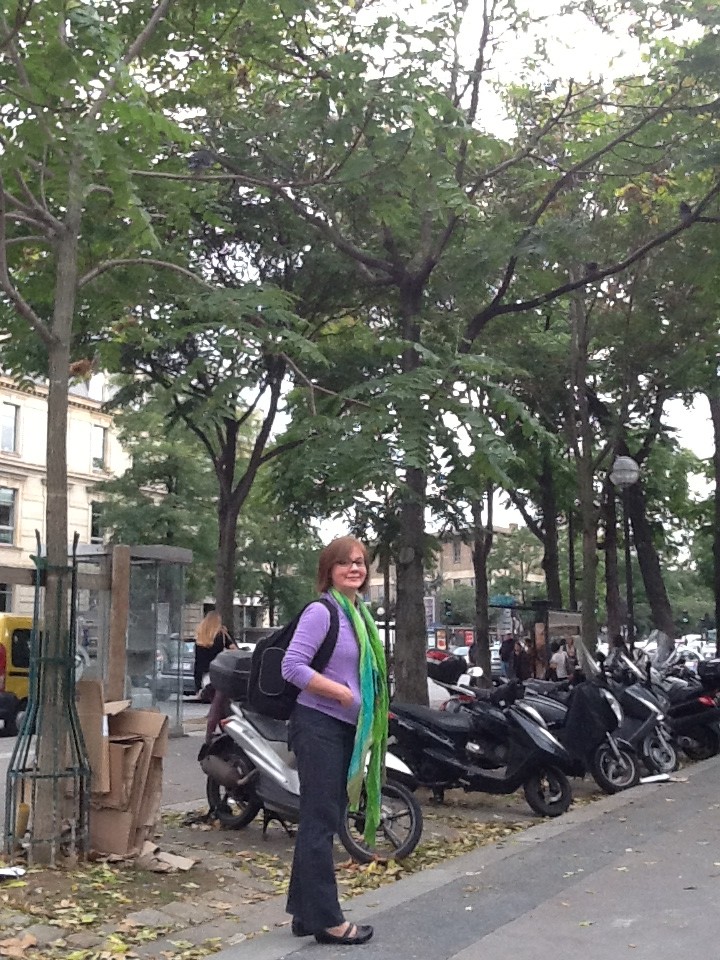
We found the Tree of Heaven, the Ailanthus altissima, growing in a neat row adjacent to the Jardin des Plantes. This was another interesting discovery, given the history of this tree and its evolution as a specimen tree and street tree in Europe and the U.S.
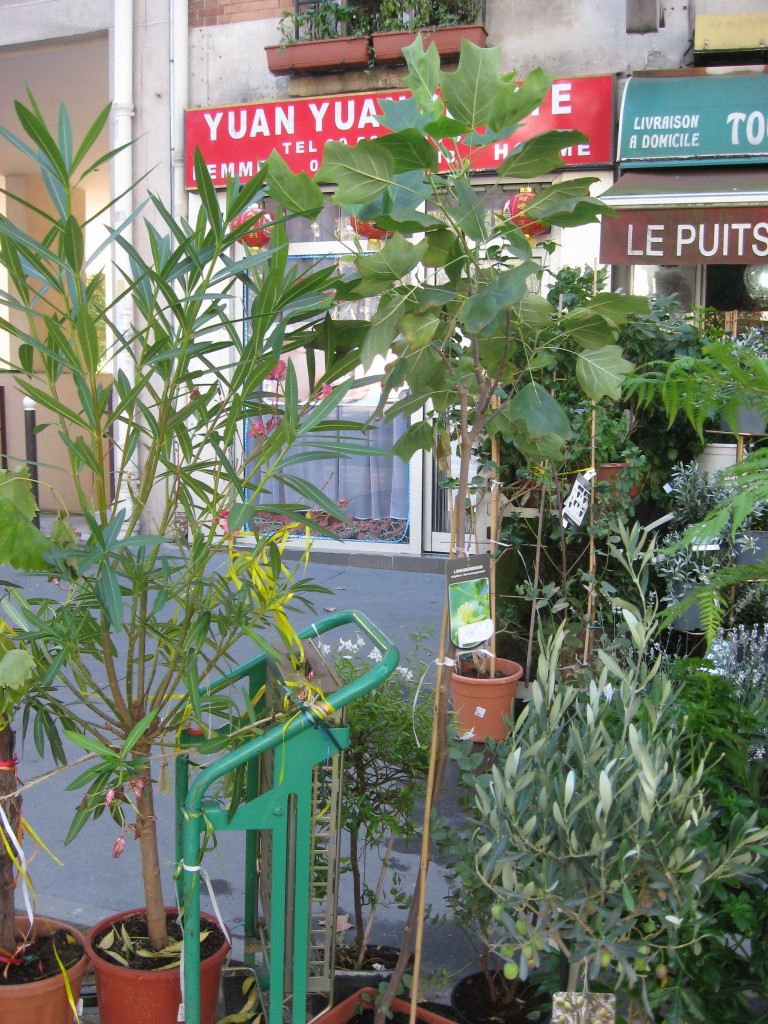
The American Tulip Poplar, Liriodendron tulipifera, has been discovered by the French. Here, this tree is being sold on the street in Paris. We have found it being planted along streets in Paris as well. This fast growing tree grows a very straight trunk, has attractive leaves and magnificent tulip sized orange flowers. As a street tree, it poses a problem because the wood is weak and the branches are easily broken off, creating a potential danger to property and life. Â Maybe the City Of Paris can keep up on the maintenance of the Tulip Poplar enough to mitigate this issue.
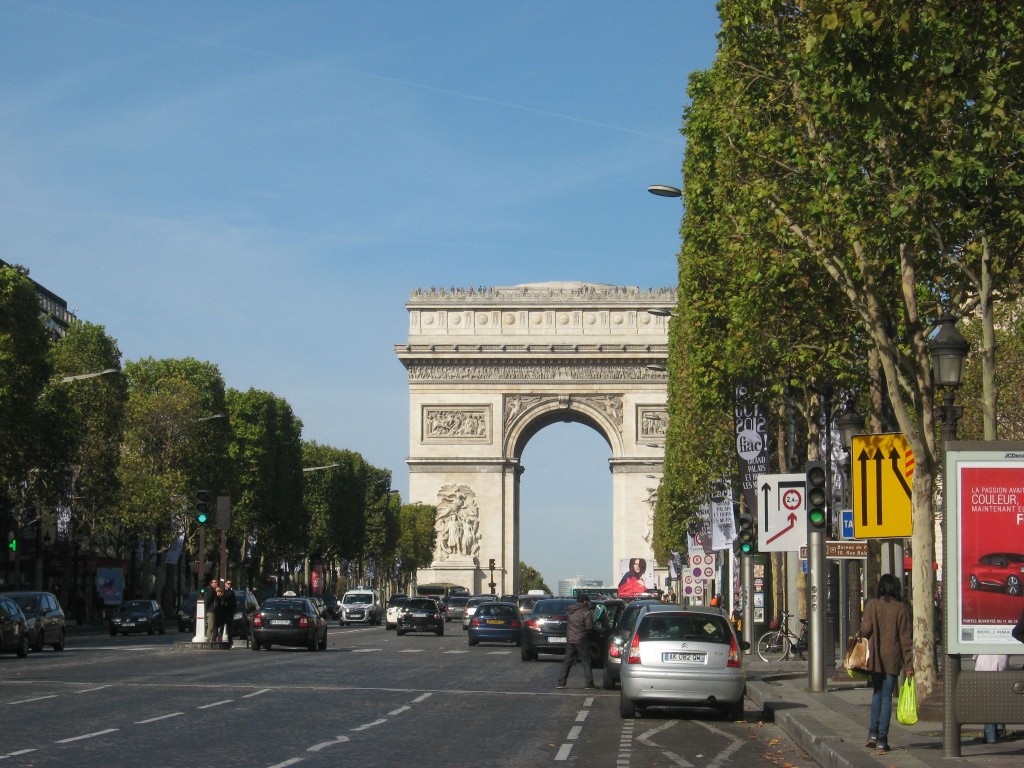
Saving the best for last, dear readers, we have found ourselves on the Champs-Elysees in Paris, one of the most iconic streets in the world, one of the most visited and celebrated, it is a street that lives up to its mythology, it is awe-inspiring and truly memorable; its grandiosity and stature have reached a global definition of the formal road, where there is a location and a direction that can easily identify a nation and a history.
The Champs-Elysees is a proud boulevard and it defines a formal elegance, unmatched and much noticed and appreciated.
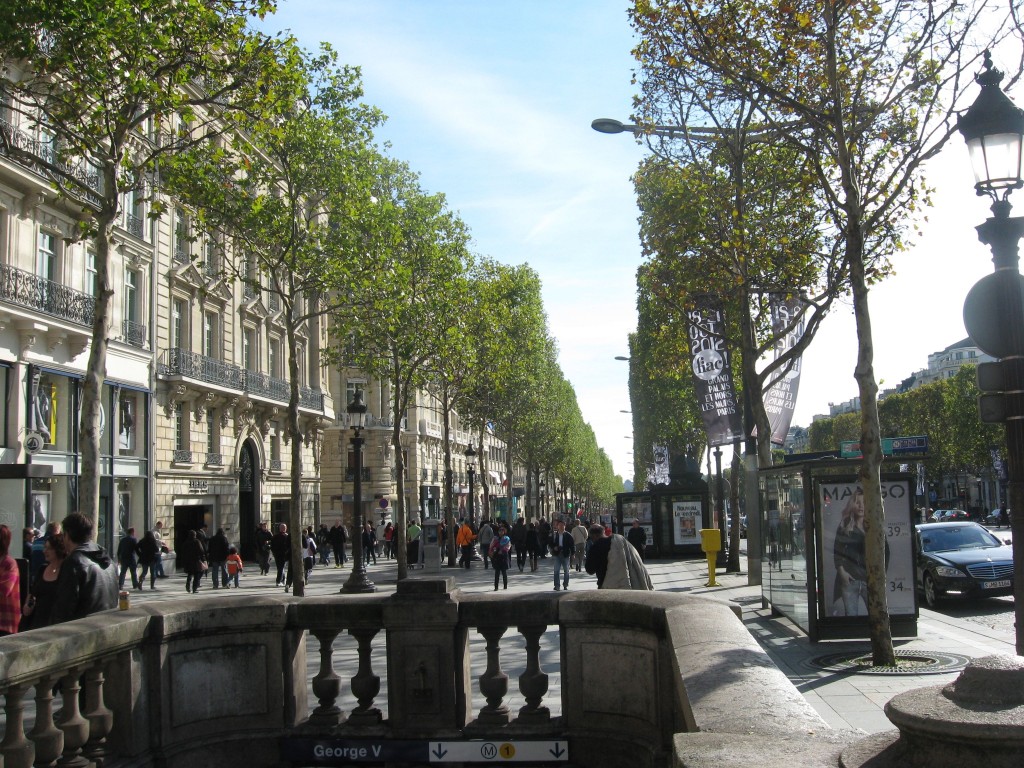
The Champs-Elysees, this aesthetically pronounced allee of magnificence and stately grandeur is lined with the London Plane, a storied tree worthy of its place in the history of street trees.
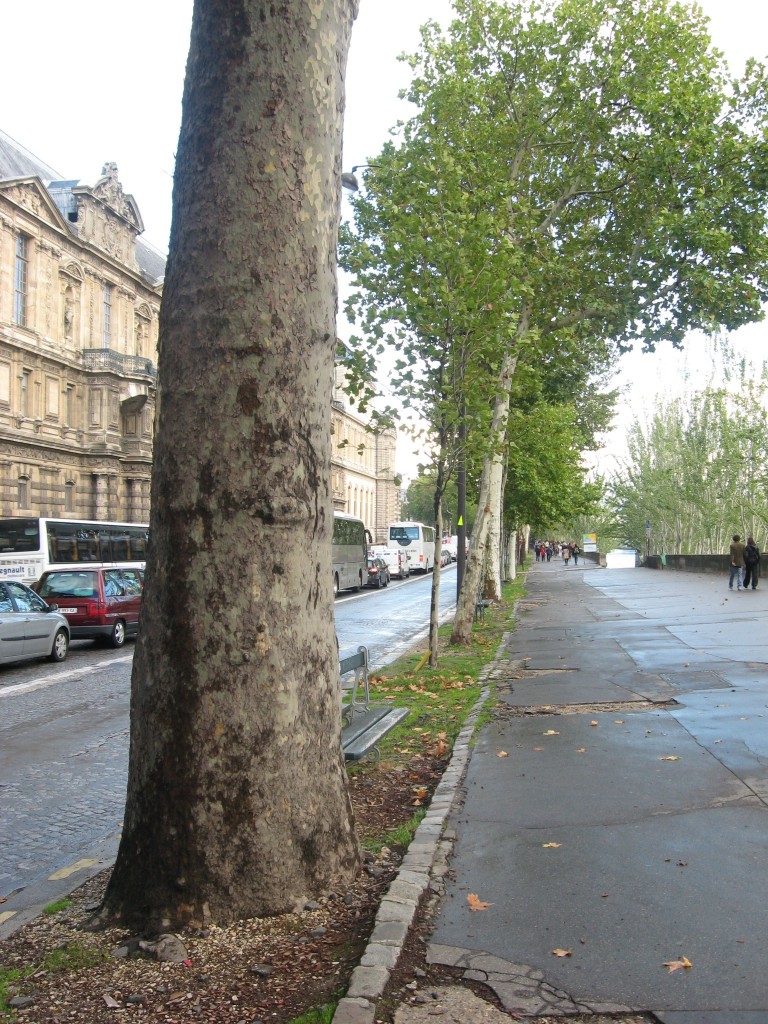
Platanus x acerfolia
Alongside the Louvre, the Plane tree has been planted, and we are among the privileged to see them in their mature and healthy state.
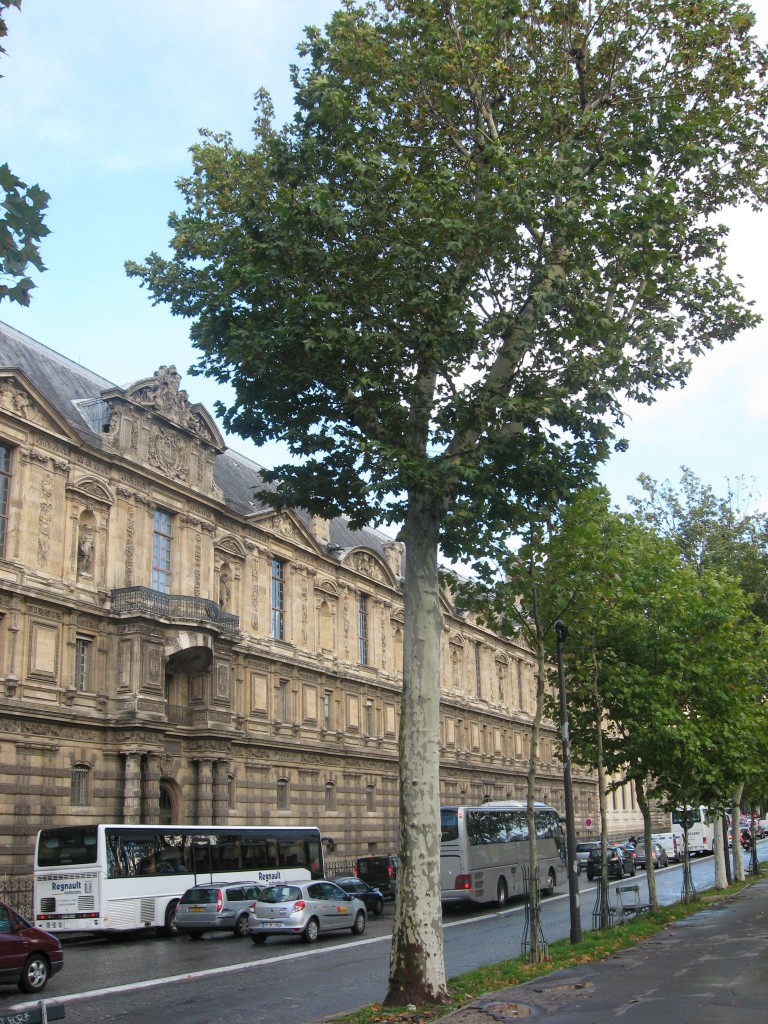
On this block, London planes are still being planted to replace the ones that have died.
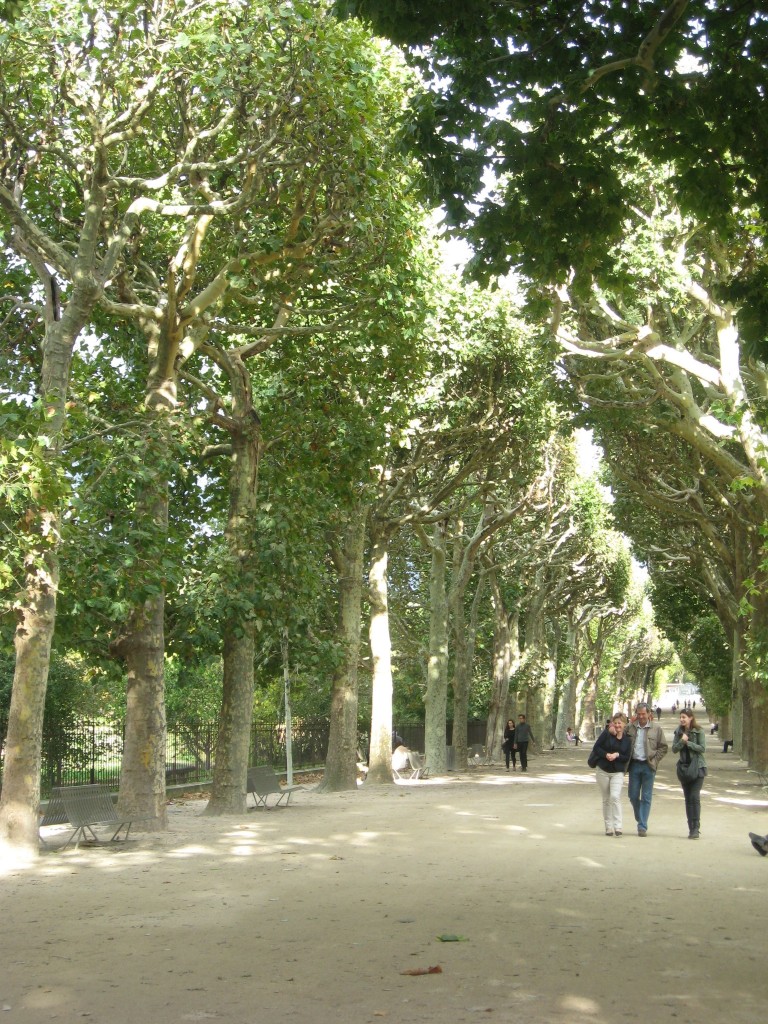
The London Plane, a cross between the American and Asian Sycamore has been a favorite street tree because of its ability to withstand harsh conditions.  In its natural environment, these trees are found along waterways.  In the South of France, they have become diseased, caused by the fungus Ceratocystis platani  and many of them are being destroyed.  The disease has been found to have originated from ammunition casings made of the American Sycamore wood, brought over by American soldiers in WWII.
If the disease reaches Paris, there could be a devastating loss of street trees, from the Champs- Elysees to the Jardin Des Plantes as well as throughout the city. The idea of an allee of identical trees may become a questionable practice as whole streets become treeless in one episode of blight, like the American Elms that were destroyed by the Dutch Elm Disease, rendering whole towns across America treeless. Some streets in Paris are already showing signs that the city is bracing itself for the worst: new trees being planted are of a different species than the dominant, breaking the tradition of continuity and implementing a practice of diversification. With street trees, the lesson is about not putting all of your eggs in one basket as the saying goes.
Exploring Paris has been fun and educational on many levels, the street trees being the latest subject of interest. Observing and thinking about them has been eye-opening in that we can get an understanding of the history of the city by the trees that have been planted and where, how old they are, how they are being maintained, and what is being currently planted. The landscape reflects a botanical history of the city; what is of interest and desire, and what foreign trees the city is willing to plant. Â Trees have also taken part in the aspirations of the city, as well as the nation, maintaining and reflecting the ideals of a society and its relationship with the natural world.
It is encouraging to see that ecological concepts are being utilized in some areas, respecting that of genetic diversity and the appropriate responses to plant diseases and their causes.
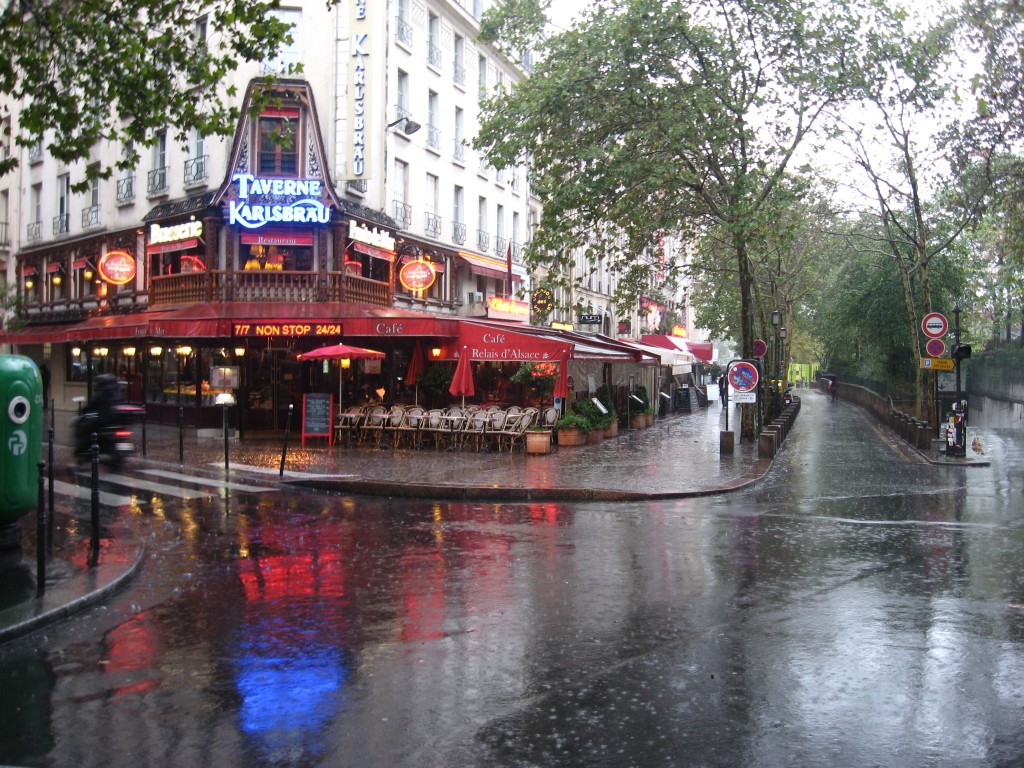
One more thing as we saunter through the city of Paris: The more we learn of the city and the more we discover of its past, the more we learn about where we live, by contrast and comparison alone. When we consider cities as ecologically relevant, as places for human ecosystems to maintain themselves, this ideal is served so much better by the observations of the concerned.
It is well worth the trip, especially when we bring our observations home.
Please join us again for our next adventure!
Please read our article Americans in Paris for more!



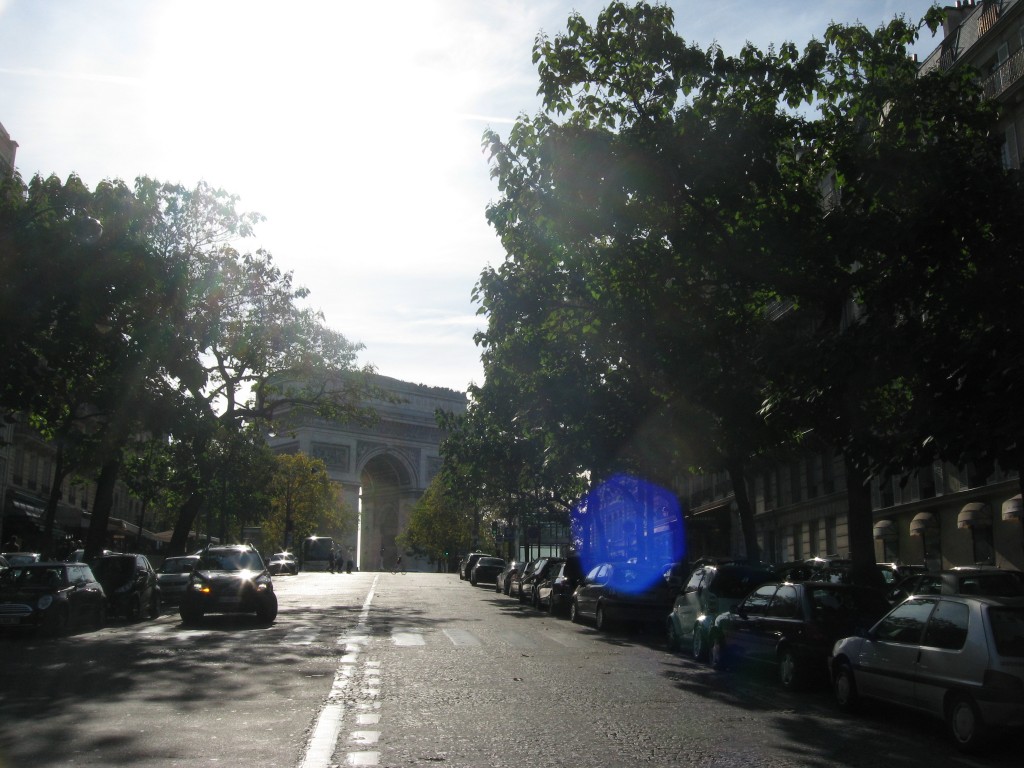
This is exactly what I needed! I’m modeling some trees for an assignment and this helped me a lot.
Thank you for this post! I really like the different take on visiting such a famous city. I found your blog while researching different trees for a poem I am writing.
You are Welcome Vincent! Hope to read your poem when it’s finished!
Very interesting blog. A question from Australia here. I was watching the Paris -Roubaix race ( April it was), and there were lots of round shaped trees covered in yellow flowers. Both in suburbs and along country roads. Would you know what are they , please?
Thanks for your blog. Beautiful. I often think how lovely it would be if I could plant trees on the sidewalk, or at least in my sidewalk. Do you happen to know how we can do that? Which department gives authorization for that? How do they water those trees?
Thanks
Elizabeth
Elizabeth, contact your parks Department or streets department in your town or city. Usually they will have a list of approved trees and you may have to buy the tree or you may find an organization that can donate the costs. Sometimes unlucky folks will have sidewalks that have too many issues such as multiple gas lines, pipes etc. and trees will not be allowed to be planted. Hopefully that is not your case.
HELP… I’ve just come across your page. We’re fellow Philadelphians, in Paris for a bit. And we’ve got a son in school here. He has a class science project where they need to identify leaves… but we’re coming up blank on one particular variety (elliptic with a “whole” margin (no teeth), alternating leaves, small point at the top and no heart shape at the bottom… all of which says to us beech… except it also has a white-gray, willowy bud (even though it’s fall) and what looks like a small, cranberry sized berry or nut, growing out of a green shell). Any idea what that could be? You can write me at the regular address, if you like, and I can send a picture… project is due tomorrow!!!
the first time i went to paris in 1988… i remember some very beautiful trees of a lavander/lilac hue..en -masse..these seemed to grow tall by apartments sporting stripey awnings in february sunshine.. i dubbed it tree of heaven! because they were so gorgeous and i had never seen such a tree in february… back home in ireland.. i saw the trees from a train window, when travelling from le havre to paris… somewhere in the middle. the only tree i find online that (to me is it) is acaranda…. but since this originates in south america and thrives on heat… would that be possable in northern france in february? and advice appreciated.
Sean, I finally made my first trip to Paris as you know. I did notice how few street trees there were (at least in the areas we visited). I was thinking the same that there is not much room for them and the sidewalks are somewhat narrow in some places. Beautiful pictures that I can now actually relate to, thanks…… I
I, too, am writing a book which has an important section in Paris. I am also describing and identifying trees in my book, to create a sense of place. I was in in Paris last July, so I did not see the Horse Chestnut trees in bloom. I would appreciate it if you could help me with the following questions about the colors of the flowers when the trees are in bloom.
1. What are colors of the flowers of the Horse Chestnut trees lining the fashionable Avenue Montaigne, and in which month do they usually flower? The area of the street of interest are the chestnut trees across the street from the the Plaza de Athenee Hotel which houses the Alain Ducasse restaurant.
2. I am also interested in what color the flowers of the chestnut trees are in in the Parc Ranelagh, and when they usually flower. The Parc Ranelagh is elegant and quiet and near the Musee Marmottan. There are at least two edges of the Parc Ranelagh which are lined with double rows of what seem to me to be relatively young chestnut trees.
Thank you so much for your help!
Very well written article and beautiful photos. Sitting in India, for a moment I found myself breathing in Paris. Well done, please continue writing.
Thank you Manan for your kind comment! We will keep writing and we always write about Paris!
Great article, great photos!
The reason behind my interest in Paris trees is that I am writing a series of short stories which take place in Paris and though my stories are fictional, the setting is very real and I want to be as exacting as possible with details like, for example, trees.
I have two specific questions:
What genus of tree lines Boulevard Raspail near the Notre-Dame-des-Champs metro station?
Which trees are most numerous in the Champs de Mars (park surrounding the Eiffel Tower)
Thank you in advance of any help offered!!!
Elizabeth, Along the Av.Anatole France next to the Eiffel tower are London Plane trees (Platanus x acerifolia), however there are other types of trees in the park. The Ave Anatole is the most prominent one, leading up to the tower.If you have any pictures of the trees around Ave Raspail near the Notre-Dame-des-Champs metro station, please send them to me and I can try to identify them, because I cant find any of my own. Usually Paris boulevards are London Plane or Horse-Chestnut and the third most common one is the Linden tree. It is great that you are including the details of the trees in your story!
Moving to Loire Valley. Have a South facing house. Would it be possible to grow a jacaranda tree successfully?
David,
We’re also in the Loire Valley and would like to plant a Jacaranda. Did you plant one? Wa it successful?
thanks
Melanie
Missed the trees we saw last month in Paris along Carnot, leading to Arc de Triumph. They were beautiful tall trees lining both sides of the street, with large purple flowers very similar to purple lilacs. We could not find anyone who could tell us what they were. Can you?
David, Great question! Isabelle and I walked up ave Carnot last Fall and took a few pictures of those trees, which are featured in the middle of this article. They are commonly called the Empress Tree and the latin name is Paulownia tomentosa. What a beautiful sight they must have been all in full bloom! Unfortunately, this asian native which was historically planted as a street tree, has become a problematic invasive and has adapted all too well to the urban environment.
What a wonderful trip through Paris!!! It is indeed a beautiful city!
Thanks Connie, Paris is a beautiful city.
You can almost touch Paris in the beautiful pictures. I so wish to go one day!!
Joyce, thank you! You should visit Paris.
A delightful tour of Paris – that Empress tree is especially gorgeous, but your entire tour was a real treat.
M.
The blooms of the Empress are also eye catching.
Mike, it would be interesting to hear your perspective of the City if you visit.
An excellent tour. I’ve never been, but this definitely gives me some insight into the city.
Thanks for this article. This is the only place I have found reference to plane trees on the Champs Elisee. Nice photos and lovely trees.